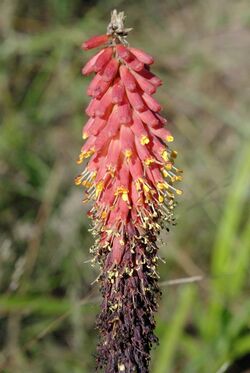Biology:Kniphofia umbrina
| Kniphofia umbrina | |
|---|---|

| |
| Kniphofia umbrina inflorescence, Hhohho Region, Eswatini. | |
| Scientific classification | |
| Kingdom: | Plantae |
| Clade: | Tracheophytes |
| Clade: | Angiosperms |
| Clade: | Monocots |
| Order: | Asparagales |
| Family: | Asphodelaceae |
| Subfamily: | Asphodeloideae |
| Genus: | Kniphofia |
| Species: | K. umbrina
|
| Binomial name | |
| Kniphofia umbrina Codd
| |
Kniphofia umbrina, called the Eswati poker, is a species of flowering plant in the genus Kniphofia.[2] The species is native to an area near Forbes Reef in Eswatini, just to the north of Mbabane.[1]
Description
Plants are herbaceous perennials which may grow up to 1.8 metres (5.9 ft) tall. Stems emerge from a thick rhizome, with 6-8 leaves per stem.[1] Flowers are brown, slightly scented, and form a raceme. It is similar in characteristics to Kniphofia typhoides.[3]
Habitat
The species is native to sourveld, rocky grassland in a temperate climate.[1] Soils in the area are acidic, high in clay and organic matter, and serpentiferous.[4] Their observed distribution covers approximately 40 square kilometres (15 sq mi). The habitat falls on Swazi Nation Land, as well as on the Hawane Nature Reserve.[5]
Conservation
The species was first listed by the IUCN as vulnerable in 1978 after a detailed survey. There were between 3,000 and 4,000 estimated individuals. The population was initially threatened by maize cultivation and road construction.[1] Conservation measures were undertaken, including translocating individuals into Malolotja Nature Reserve and collecting seeds.[5] The population of 1,900 transplants eventually went extinct.[4]
Between 1978 and 1985, the population declined 92%, down to only 357 known plants. This was attributed to increased pressure by grazing, agriculture, and the construction of a dam. In 2001, the species was reassessed as critically endangered.[4]
References
- ↑ 1.0 1.1 1.2 1.3 1.4 Synge, Hugh (1978) (in en). The IUCN Plant Red Data Book: Comprising Red Data Sheets on 250 Selected Plants Threatened on a World Scale. International Union for Conservation of Nature and Natural Resources Threatened Plants. p. 309. ISBN 978-2-88032-202-1. https://books.google.com/books?id=bBmv_LQznyIC&pg=PA309. Retrieved 15 August 2021.
- ↑ "Eswati Poker (Kniphofia umbrina)" (in en-US). https://www.inaturalist.org/taxa/588300-Kniphofia-umbrina.
- ↑ "Kniphofia umbrina in Global Plants on JSTOR". https://plants.jstor.org/compilation/Kniphofia.umbrina.
- ↑ 4.0 4.1 4.2 Witkowski, E. T. F.; Dahlmann, L. A.; Boycott, R. C. (1 November 2001). "Conservation biology of Kniphofia umbrina, a critically endangered Swaziland serpentine endemic". South African Journal of Science 97 (11): 609–616. https://journals.co.za/doi/10.10520/EJC97233. Retrieved 15 August 2021.
- ↑ 5.0 5.1 "Endemic Flora: Kniphofia umbrina". Eswatini National Trust Commission. http://eswatininaturereserves.com/biodiversity/endemics2.asp.
Wikidata ☰ Q15574304 entry
 |


